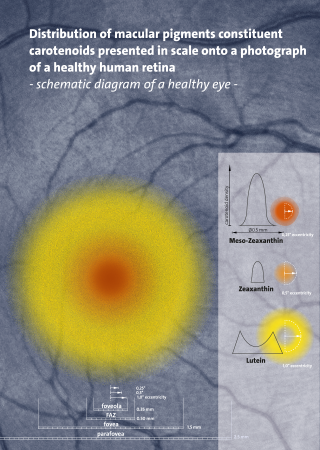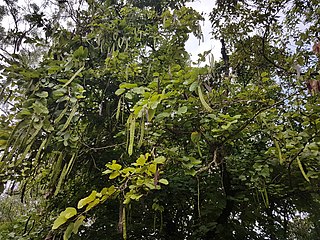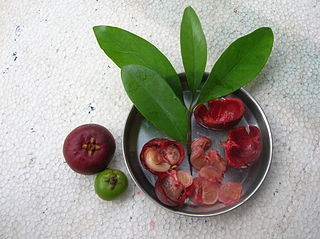
Carotenoids are yellow, orange, and red organic pigments that are produced by plants and algae, as well as several bacteria, archaea, and fungi. Carotenoids give the characteristic color to pumpkins, carrots, parsnips, corn, tomatoes, canaries, flamingos, salmon, lobster, shrimp, and daffodils. Over 1,100 identified carotenoids can be further categorized into two classes – xanthophylls and carotenes.

Garcinia is a genus of flowering plants in the family Clusiaceae native to Asia, America, Australia, tropical and southern Africa, and Polynesia. The number of species is disputed; Plants of the World Online (POWO) recognise up to 400. Commonly, the plants in this genus are called saptrees, mangosteens, or garcinias, and is one of several plants known as by the name "monkey fruit".

Magnolia virginiana, most commonly known as sweetbay magnolia, or merely sweetbay, is a member of the magnolia family, Magnoliaceae. It was the first magnolia to be scientifically described under modern rules of botanical nomenclature, and is the type species of the genus Magnolia; as Magnolia is also the type genus of all flowering plants (magnoliophytes), this species in a sense typifies all flowering plants.

Persicaria odorata, with common names Vietnamese coriander, rau răm, laksa leaf, Vietnamese cilantro, phak phai, praew leaf, hot mint, Cambodian mint and Vietnamese mint, is a herb whose leaves are used in Southeast Asian and Northeast Indian cooking.

The Controlled Drugs and Substances Act is Canada's federal drug control statute. Passed in 1996 under Prime Minister Jean Chrétien's government, it repeals the Narcotic Control Act and Parts III and IV of the Food and Drugs Act, and establishes eight Schedules of controlled substances and two Classes of precursors. It provides that "The Governor in Council may, by order, amend any of Schedules I to VIII by adding to them or deleting from them any item or portion of an item, where the Governor in Council deems the amendment to be necessary in the public interest."

Bauhinia purpurea is a species of flowering plant in the family Fabaceae, native to the Indian subcontinent and Myanmar, and widely introduced elsewhere in tropical and subtropical areas of the world. Common names include orchid tree, purple bauhinia, camel's foot, butterfly tree, and Hawaiian orchid tree.

Phenanthrenoids are chemical compounds formed with a phenanthrene backbone. These compounds occur naturally in plants, although they can also be synthesized.

Garcinia kola (bitter kola is a species of flowering plant belonging to the Mangosteen genus Garcinia of the family Clusiaceae. It is found in Benin, Cameroon, The Gambia, Democratic Republic of the Congo, Ivory Coast, Mali, Gabon, Ghana, Liberia, Nigeria, Senegal and Sierra Leone. Its natural habitat is subtropical or tropical moist lowland forests.

Benzphenone-1 – benzophenone-12 are UVA/UVB absorbers. Some of them are used in sunscreens.

Aegiceras corniculatum, commonly known as black mangrove, river mangrove, goat's horn mangrove, or khalsi, is a species of shrub or tree mangrove in the primrose family, Primulaceae, with a distribution in coastal and estuarine areas ranging from India through South East Asia to southern China, New Guinea and Australia.

A xanthonoid is a chemical natural phenolic compound formed from the xanthone backbone. Many members of the Clusiaceae contain xanthonoids.

Senna reticulata, the mangerioba grande or maria mole in Portuguese, is a pioneer tree species found on highly fertile floodplains in South America. It has some medicinal uses, but is regarded by farmers as a noxious weed, named matapasto due to its ability to grow fast and outshade neighbouring plants.

Garcinia indica, a plant in the mangosteen family (Clusiaceae), commonly known as kokum, is a fruit-bearing tree that has culinary, pharmaceutical, and industrial uses. It primarily grows in the Western Ghats, especially the Goa and Konkan region.
Pseudoprospero is a genus of bulbous flowering plants in the family Asparagaceae, subfamily Scilloideae. The genus has a single species Pseudoprospero firmifolium, which is endemic to South Africa.

Homoisoflavonoids (3-benzylidenechroman-4-ones) are a type of phenolic compounds occurring naturally in plants.
Garcinia forbesii, commonly known as the rose kandis or kandis, is a small to medium-sized tree in the family Clusiaceae (Guttiferae). The specific epithet (forbesii) honors Scottish naturalist Henry Ogg Forbes.
Garcinia magnifolia, also known as bebasajo or giant leaf madrono, is a flowering tree in the family Clusiaceae (Guttiferae). The specific epithet (magnifolia) comes from Latin magni and folia, and refers to the plant's large leaves.
Garcinia benthamiana, also known as asashi, is a flowering tree in the family Clusiaceae (Guttiferae). The specific epithet (benthamiana) honors English botanist George Bentham.
Garcinia leptophylla is an evergreen flowering tree in the family Clusiaceae (Guttiferae). The specific epithet (leptophylla) comes from Greek leptos, and phyllon, and refers to the plant's slender leaves.

Garcinia talbotii is a large tree in the family Clusiaceae and is endemic to the Western Ghats of India. The tree has yellow latex, and can attain a height of 25 m and girth up to 2.2 m. This species was first reported from Gairsoppah Ghats in North Kanara of Karanataka district.
















